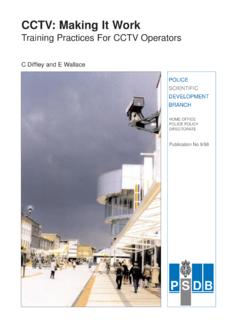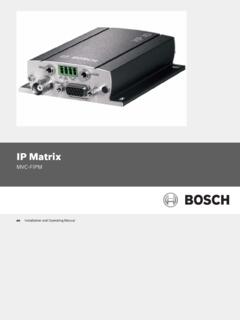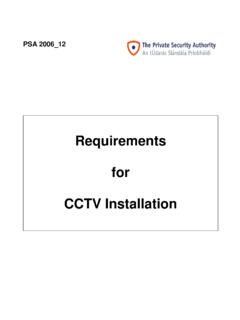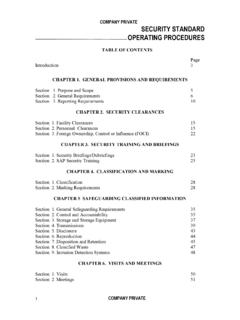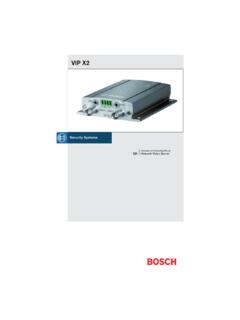Transcription of CCTV Systems within Licensed Premises - moretonalarms.com
1 cctv Systems in Licensed Premises Version November 2004 1 cctv Systems within Licensed Premises operational requirements ( ) cctv Systems in Licensed Premises Version November 2004 2 cctv Systems within Licensed Premises Introduction Cheshire Constabulary recognises and supports the effective use of cctv technology in preventing and detecting criminal behaviour and providing good quality images that can be later used for investigation purposes. The majority of towns and city centres in Cheshire are monitored and protected by the Police and Local Authority (Crime and Disorder Partnerships) cctv public surveillance Systems , however many incidences of alcohol related offences occur in and around Licensed Premises .
2 Alcohol-fuelled violence is on the increase and with crime figures showing almost half of all violent crime being carried out by people under the influence of alcohol and approximately 70 per cent of weekend A&E admissions being drink-related then it is imperative that managers and designated supervisors of Licensed Premises consider their obligations to providing a safe drinking venue. The purpose of this guidance document is to assist in providing technical advice and guidance to managers and supervisors of Licensed Premises when purchasing, specifying or installing a cctv system . The primary objectives of installing a cctv system within Licensed Premises are: To seek to influence behaviour of patrons. To prevent or detect underage alcohol sales.
3 To protect staff and property. To assist with good management practices. Where necessary, to provide unequivocal evidence of an incident to assist subsequent prosecution. The following guidance also seeks to assist the manager in the cctv procurement process. It provides a checklist of criteria, which is required for the specification of an effective cctv system and has been produced in accordance with the advice provided by the Police Scientific Development Branch (PSDB). Proposed cctv installations for Licensed Premises in Cheshire, Halton and Warrington are advised to consult with the Force Architectural/ cctv Liaison Officer on 01244-61-4567 or the local Crime Reduction advisor prior to installation to ensure that they comply with the requirements of this guidance document.
4 The advice and support is provided free of charge. cctv Systems in Licensed Premises Version November 2004 3 Common problems associated with cctv recorded images. Here are some examples of faults often found with poor quality Systems : - a) The subject is too small and it is out of focus. b) The images of moving subjects are blurred and contain no detail. c) Cameras are sited in the wrong place or are not pointed in the right direction. d) There is insufficient light or too much glare on the subject. e) The digital recorder was not working. f) The digital recorder did not have a large enough hard drive to record all cameras over a 21-day period. g) The system has never been maintained and quality checks have never been carried out. operational Requirement Analysis What is an operational Requirement?
5 A statement of needs based on a thorough and systematic assessment of the problems to be solved and the hoped for solutions. In its simplest form an operational Requirement ( ) makes the reader ask a series of simple questions: Why am I installing a cctv system ? What do I want it to do? Where should I install cameras? How should I record the images? Is the digital video recorder capable of retaining images for 21 days? Will it provide adequate images for investigative purposes? When a client contracts an installer to design a cctv system the installer will require certain information to enable them to create the specification for an effective system . It is unlikely that you as the client will have sufficient technological knowledge to specify which equipment is required.
6 The use of an approach simplifies the process and reduces the opportunities for confusion which may lead to a non-compliant installation. The should answer the following questions: cctv Systems in Licensed Premises Version November 2004 4 Who and/or where is to be observed? Who - Patrons and/or staff Where - Areas of Interest Staircase for Health and Safety purposes (prevent litigation) Main Entrance Till / Bar area Overt and/or Covert cameras ( integrated cash register cctv transactions) Areas out of view from the bar area Area outside Toilets Cash Machine / Gambling Machines Office / Storage Car Park Which activities are of concern? Incidents of disorder Assaults Theft of property Damage to property Dealing of drugs Drug abuse Suspicious actions Why are the activities being observed?
7 To monitor behaviour To recognise and identify offenders To produce physical evidence of incidents which may subsequently be used in Court Picture quality The quality of images recorded is of paramount importance. They should therefore: Clearly show actions of persons involved in an incident Give evidence of identity of offenders Show an overall view of the scene (show possible witnesses) Confirm date and time of incident Digital Video Recorder Specification What is the size of the harddrive? Is it capable of doing what I ask? Can I download evidential images onto a removable medium CD-R. Page 13 of this document can be used as a template for recording your Images There are four image standards: cctv Systems in Licensed Premises Version November 2004 5 Monitor Detect Recognition Identification The quantity and location of cameras will be site specific.
8 They must meet the requirements identified within the procedure. All cameras must produce colour images to enable accurate identification of offenders. All external public access doors must be fitted with cameras, which enable clear, unobstructed images of all persons entering/exiting the Premises . Where practicable, these cameras should be mounted internally. Such cameras must be mounted at a suitable height - looking towards, rather than down at the doorway. cctv Cameras are susceptible to interference and vandalism and should therefore be fitted with robust anti-tamper housings to prevent such actions. Cheshire Constabulary would recommend that a drawing be used to plan on the location of each camera.
9 The performance requirements for each camera should also be presented to the installer as per the on page 13. Monitors cctv Systems in Licensed Premises Version November 2004 6A colour monitor must be provided with the system to view recorded images. This monitor must be located in a secure location so that unauthorised personnel cannot view it. However, consideration should also be given to having monitors located behind the bar area so that vulnerable areas can be observed upstairs, behind recesses. Cheshire Constabulary recommends that some Premises install a deterrent monitor in the vicinity of the main entrance public access doorway(s). This monitor should display images produced by the camera covering the said doorway.
10 It must not display images produced by any other camera located within the Premises . Patrons entering the Premises will then be made aware of the quality of the images and the fact that their images are being recorded thus enhancing the Systems potential deterrent value. Image Retention The Data Protection Legislation states that images should be kept for no longer than is necessary. Cheshire Constabulary recommends that images for the purposes of prevention and detection of crime in Licensed Premises should be retained for at least 21 days on a digital system and 31 days on a video tape (analogue) system . The frame rate (compression type) should include 6 frames per second per camera and more than 12 frames per second at the camera located at the main entrance.


